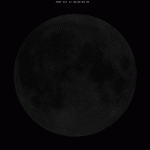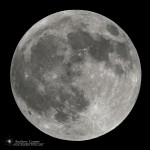Saturn will be about 7.5° from the Moon when they rise tonight. A 73% illuminated Moon will rise about 22:28, followed by Saturn at 22:58HST. The Moon will also be quite close to the bright star Spica, less than two degrees away from the 1st magnitude star.
Category: Lunar Events
Waxing and waning from new to full and back again
Venus and Uranus
This evening Venus and Uranus are very close, with the pair separated by a mere 19 arc-minutes, about 1/5th of a degree and well within the same medium power telescopic field. This a is chance to find the ice-giant with relatively little effort, there will be no nearby bright stars to confuse with the 5.9 magnitude Uranus. At high magnification both planets will be seen as disks, Venus 16 arc-seconds across, and Uranus a bit over 3 arc-seconds across. Venus is now far enough between the Earth and the Sun to become somewhat gibbous, being about 70% illuminated.
Full Moon
Venus and Uranus
Over the next few night Venus will pass very close to Uranus. The pair will be close for about five days, around 2° or less from the 7th to the 11th. It is on the 9th that the closest approach will occur with the pair separated by a mere 19 arc-minutes, about 1/5th of a degree and well within the same medium power telescopic field. This a is chance to find the ice-giant with relatively little effort, there will be no nearby bright stars to confuse with the 5.9 magnitude Uranus. At high magnification both planets will be seen as disks, Venus 16 arc-seconds across, and Uranus a bit over 3 arc-seconds across. Venus is now far enough between the Earth and the Sun to become somewhat gibbous, being about 70% illuminated.
The Moon and Pleiades
Tonight a bright gibbous Moon will be just under 5° from the Pleiades star cluster. The Moon will be 62% illuminated, bright, but the cluster is bright enough to be seen even against a bright Moon. As the Pleiades move to the west over coming months there will be a few more lunar conjunctions, with increasingly smaller crescents.
The Moon and Jupiter
Tonight will see a brilliant Jupiter near the Moon. The pair will be separated by about 5.5° high in the evening sky. Jupiter will shine brightly at -2.4 magnitude, a nice match for a 41% illuminated Moon.
The Moon and Venus
The Moon and Venus were quite close last night, about 8° with the Moon below the brilliant Venus. Tonight the Moon will be above Venus, about 9° away.
The Moon and Venus
This evening a nice crescent Moon will join Venus in the dusky sky. The pair will be reasonably close, about 8° apart. Venus is currently shining very brightly at about -4.1 magnitude, contrasting nicely with a 9% illuminated Moon. The two will still be close tomorrow, about 9° apart with the Moon 15% illuminated.
New Moon
Lunar Apogee and Perigee
Does the Moon seem a little larger and brighter than usual? It may not be an illusion, sometimes the Moon really does look a little larger or smaller in the sky.
Like all orbiting objects, the Moon does not orbit in a perfect circle, but rather in an ellipse. This means that as it orbits it is a little further away or a little closer. In the case of the Moon the difference is not much, but you can see it, if you know to look.


The period of time between full Moons, the synodic month, is about 29.5 days. While lunar perigee occurs every 27.5 days, an anomalistic month. Since these periods are not equal, the cycle drifts in and out of phase. About once a year the cycles coincide and full Moon and apogee or perigee will occur near the same time.
At apogee, the Moon will be appear about 29 arc-minutes in size, a little less than half a degree. At perigee the Moon will be about 33 arc-minutes across, a bit more than half a degree. The numbers may not seem like much, but it is a visible difference. The simulated images shown here will give a better idea of what the numbers represent.
This change in size and distance leads to the moonlight being a bit brighter at perigee than at apogee, about a 30% difference. So if that moonlit night seems brighter than you remember it may actually be the case.


